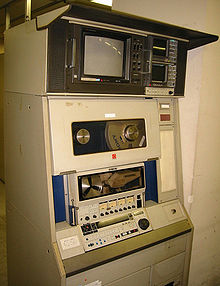Type C videotape

Sony BVH-2000 1 inch VTR
|
|
| Media type | Magnetic Tape |
|---|---|
| Encoding | NTSC, PAL |
| Read mechanism | Helical scan |
| Write mechanism | Helical scan |
| Developed by | Sony |
| Usage | Television production |
1 inch Type C (designated Type C by SMPTE) is a professional reel-to-reel analog recording helical scan videotape format co-developed and introduced by Ampex and Sony in 1976. It became the replacement in the professional video and broadcast television industries for the then-incumbent 2 inch Quadruplex videotape (2 inch Quad for short) open-reel format, due to the smaller size, comparative ease of operation (vs. 2 inch) and slightly higher video quality of 1 inch type C video tape recorder (VTR). 1 inch type C required less maintenance downtime than Quadruplex videotape, and did not require time base correction to produce a stable video signal.
1 inch Type C is capable of "trick-play" functions such as still, shuttle, and variable-speed playback, including slow motion. 2 inch Quadruplex videotape machines lacked these capabilities, due to the segmented manner in which it recorded video tracks onto the magnetic tape. Also, 1 inch Type C VTRs required much less maintenance (and used less power and space) than did 2 inch machines.
1 inch Type C records composite video at a very high video quality that is superior to contemporary color-under formats such as U-matic, and of comparable quality to analog component video formats like Betacam and MII. Both analog component formats were notoriously fussy and trouble-prone, so in practice Type C gave a stable, more reliable picture than the broadcast quality analog cassette-based videotape formats. Because television was broadcast as a composite signal, there was no real downside to Type C in television broadcasting and distribution.
...
Wikipedia
